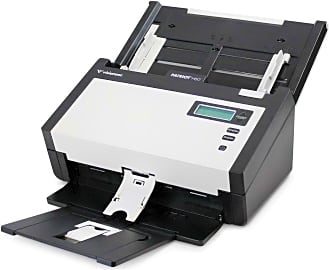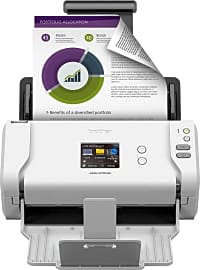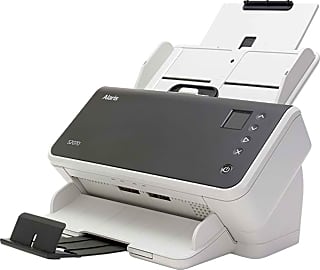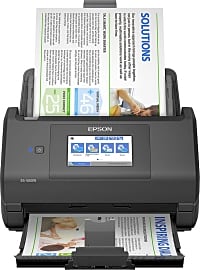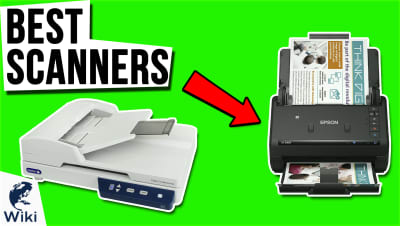The 10 Best Sheet Fed Scanners

This wiki has been updated 38 times since it was first published in February of 2016. Commonly found in busy offices, document scanners help digitize your home's or office's documents, invoices, memoranda, payment checks, recipes, and more, converting them to searchable resources that you can store on a local computer or in the cloud. They range from heavy-duty, multi-page machines for large workplaces, to single-sheet, battery-powered models that can fit in a briefcase. When users buy our independently chosen editorial selections, we may earn commissions to help fund the Wiki.
Editor's Notes
March 31, 2021:
The somewhat recent release of the Fujitsu ScanSnap iX1600 means we've left behind its older relative, the iX1500. The only major difference between the two is that the new one is about 30 percent faster, and since they're the same price, you might as well get the faster one. The other upgrade made to the Wiki is the Epson DS-580W, which replaces the DS-575W, and utilizes an upgraded image sensor for even better scans than before. Otherwise, there has not been much movement in this category, and the Raven Pro remains just about the most user-friendly, reliable, and full-featured model, according to even long-term users.
February 11, 2020:
There's an excellent selection of automatic document feed scanners available for the home office or small- to medium-size business. The HP ScanJet Pro 2000 is about as compact and simple as they come, and this is reflected in its low price, despite which it's actually quite well-made. The Xerox Duplex Combo is a similar price, and though it's not nearly as small, it does offer flatbed scanning and it's especially reliable for such an inexpensive option. It's an excellent choice if your office needs moderate black-and-white printing and isn't concerned with wireless connectivity. On the other hand, if it's wired Ethernet connection that you don't need, check out the Epson DS-575W, which is consistently rated among the best Wi-Fi document scanners around. If much of your work exists in the field or in other people's offices, consider the Doxie Q, which doesn't allow for massive workloads, but is highly convenient thanks to its portable nature.
Of course, part of the appeal of ADF scanners is their ability to process large amounts of documents quickly and send them straight to online repositories with automated image enhancement. If speed and high-end functionality are what you require, consider investing in something like the Visioneer Patriot H60 or Kodak Alaris S2070. The Alaris, it should be noted, is part of a line of powerful models that we've also highlighted in our Special Honors section.
In between the budget-friendly and high-end models, there are quite a few options that mid-size companies will appreciate. The ImageCenter ADS-2800W is one of the most powerful of these mid-range options, while the Brother ADS-2700W is packed with nearly as many features but costs noticeably less. The successor to a wildly popular 2013 release, the Fujitsu ScanSnap iX1500 is highly lauded by many owners; although it had somewhat of a rocky start, Fujitsu has done a great job supporting it with updated software and drivers, and most users are now quite satisfied. But one of the most interesting models is relatively new and has rave reviews across the board; the Raven Pro boasts features found on scanners considerably more expensive, including a powerful touchscreen that allows for in-depth editing. It also promises to work well with nearly any network and operating system.
Special Honors
HP Sender Flow 8500 The second generation of one of HP's enterprise-grade models, the Sender Flow 8500 offers both flatbed and automatic-feed scanning. It can power through documents far faster than most of the competition, but such quality comes at the cost of a few thousand dollars. store.hp.com
Kodak Alaris Family Available in a wide variety of sizes, Kodak's Alaris line can help businesses large and small turn paper files in to digital ones with quickness and ease. Depending on what your organization needs, you may find them a bit costly, but you'll also very likely be satisfied with their reliability and ease of use. Large companies will be especially interested in their Production series. alarisworld.com
Why Go With A Sheet Fed Scanner?
If you were to take that same job and use a sheet fed scanner to get it done, the story would look a lot different.
If you’ve ever scanned a single document on a flatbed scanner, you’re familiar with the process. You lift the lid, carefully place the document to be scanned on the surface, trying painstakingly to get it properly straight and aligned within the guidelines. You close the lid, unsure as to whether that very act somehow offset your document. You cross your fingers, hit the scan button, and wait. And wait.
It can take a long time for a flatbed scanner to get warmed up, and if you’re performing a high-resolution scan with inferior equipment, it can take a lot longer for a single page to scan. Then, imagine that you’ve got a stack of some 35 or 40 pages, and that each one needs to be scanned with equal precision. All of a sudden this task, which should, in theory, be pretty simple, stands to take the whole afternoon.
If you were to take that same job and use a sheet fed scanner to get it done, the story would look a lot different. Sheet fed scanners employ what’s known as an automatic document feeder. This implement works in much the same way that the paper feeding portion of any printer tray works. It has the ability to pull a single page at a time from a pile and feed it through a mechanical path. In the case of a printer, that path introduces the paper to inkjets or lasers. In the case of the sheet fed scanner, that paper — which already has information, text, or graphics printed on it — passes by an optical scanning mechanism.
The result is a process that you merely have to set up and let run its course. A sheet fed scanner will pull one page at a time through its body without you having to do anything more than load it up and hit start. So, instead of standing by a flatbed scanner and waiting for each page to scan, taking it out and replacing it with the next one, you can let the machine itself automate the job, and you can get back to working (or lounging at your desk, depending on where your boss is at the moment).
How To Choose The Right Sheet Fed Scanner For You
Picking a sheet fed scanner shouldn’t be too difficult a process. If you know what you’re going to use it for most often, you can pick from a few notable features to ensure you get a model that will please you.
If, for example, you work in an office that needs to scan a lot of documents, you’re going to need a professional-level scanner. These will often have greater duty cycles than the other models on the market. A duty cycle lets you know how many pages per day, week, or month that you can safely scan without the unit requiring any unscheduled maintenance.
That said, size is likely the least important thing to consider.
Homes and home offices can definitely make good use of a sheet fed scanner, as well, but they won’t need the same durability and duty cycle that you see in the higher end models. That said, there are some features of the less robust machines on the market that are very useful both to professionals and the average joe. There are sheet fed scanners, for example, that are combined with flatbed scanners, giving you the best of both worlds. These are particularly useful if you need to scan more than just paper documents, like photographs or even flat objects for archival or restorative purposes.
Good features for anyone to look out for, whether they intend their unit for personal or professional use, include tray capacity, resolution, speed, and size. Capacity refers to the amount of pages you can set up for a given job. The greater this number, the larger jobs you can set up to run automatically without you having to oversee anything. If you need to scan materials with lots and lots of pages, this can be very useful, but if your average document is only a few pages long, you can sacrifice your tray capacity in favor of another specification.
Resolution refers to a given scanners ability to more clearly render what it scans. This stat is often represented in dots per inch, and higher numbers equate to better resolution, which can be important if there are handwritten notes on a given document, and a low-res scan might render them illegible. Be careful if speed is a concern, however, as higher resolutions often come at the cost of speed. Compare the resolution of a given scanner to its count of pages per minute, and you’ll be able to balance your resolution needs with your time needs.
Finally, regarding size, sheet fed scanners can sometimes have larger footprints than their flatbed counterparts, but that doesn’t mean you should have to waste an entire desk on a scanning station. That said, size is likely the least important thing to consider. Make sure the other specifications are in place for your needs before you worry about fitting the unit into your office decor.
A Brief History Of The Scanner
The scanner as we know it was born out of the development of telephotography and fax technologies in the middle of the 19th century. These devices were used to read the information printed on a given piece of paper, translate it into a code that could travel along a telephone wire, and then be reprinted by a complementary machine at the other end of that wire. It’s that first step — the reading of a handwritten page — that lead to today’s scanners.
In 1913, the Belinograph, invented by Edouard Belin, became the first device to use a photocell to read a given page for transmission over phone lines. This technology became the standard for news agencies for nearly a century, only to be replaced as digital photo sensor technologies became smaller and less expensive.
Today’s sheet fed scanners feed papers past imaging sensors that utilize optical character recognition to identify letters and translate them into digital copies. Good OCR software will even let you instantly edit the text on a scanned document in a whole host of available software.



